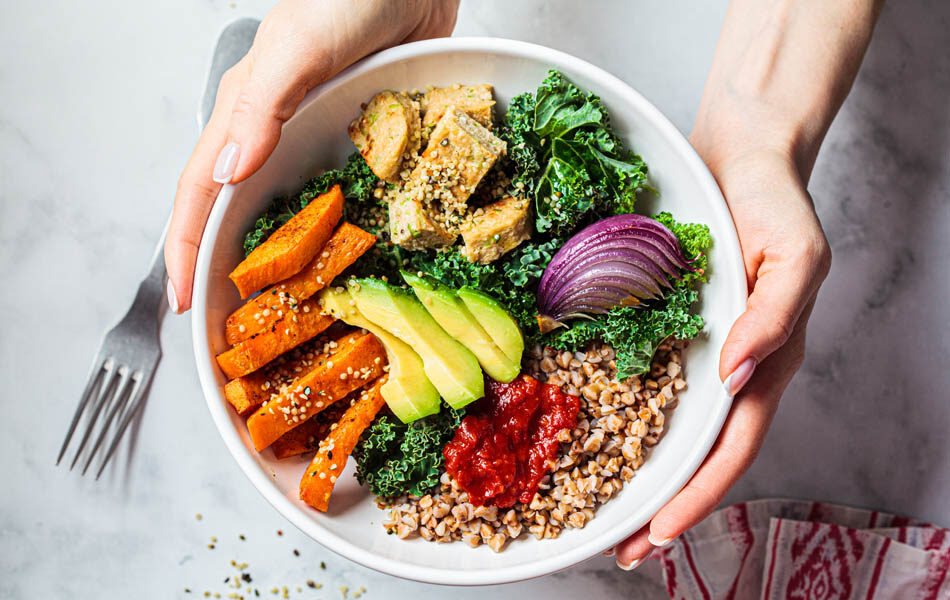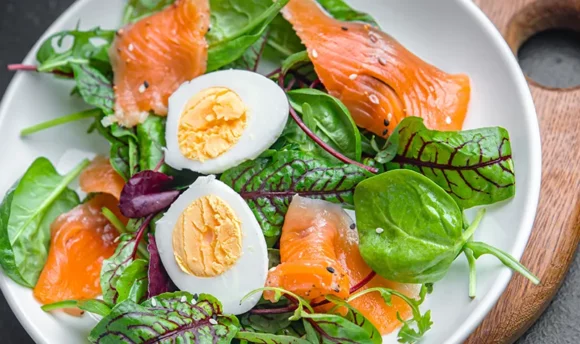Paleo vs. Keto: Which Diet Is Better?
Differences between the most common diets of this decade.

When the popularity of some diets to weight loss increases, so does curiosity due to the user’s need to know which one is more convenient.
On one side, we have the keto diet, a high-fat eating pattern that allows sustained weight loss over time with many benefits for metabolic health.
On the other extreme, the paleo diet encourages a diet similar to what humans ate before the era of industrialization. The idea of this diet is to eat as naturally as possible, free of processed foods, grains, and legumes.
Learn how to define which of these two diets is the most suitable to achieve your health goals with our Health Reporter team.
Keto vs. Paleo: What’s the Difference?
The following table shows the main differences between the paleo vs. keto diet.
| PALEO DIET | KETO DIET |
| Does not restrict the number of carbohydrates a person should eat | Carb intake is restricted to 5–10% of total daily macronutrient intake |
| Dairy products are not allowed | Dairy products can be consumed in moderation |
| It can be a high-protein diet if the user requires it | Not a high-protein diet |
| Intake of healthy fats should be low/moderate | It is a high-fat diet |
| All varieties of nuts allowed | Nuts are allowed but should be measured as they contain carbohydrates as well as good fats |
| All fruits can be consumed in quantity desired by the user | Only a few low-sugar fruit options such as berries and citrus fruits |
Are Keto and Paleo the Same?
Despite being different, both diets have some similarities, but it is important to point out that they are not the same.
The most relevant point of the paleo diet is that it is a style of nutrition that follows the pattern of the Paleolithic era, the ancestral era before the advent of agricultural practices.
The theory of the paleo diet is that the healthiest thing for our organism is to return to the diet from which our DNA has been adapted and evolving for thousands of years. This requires not eating grains, dairy products, or products with added sugar and basing our diet on animals and plants.
One of the similarities between the keto diet and the paleo diet is the fact that both of these diets don’t allow you to eat grains and legumes.
In addition, the keto diet concentrates on eating fats in order to maintain ketosis, which activates the burning of body fat to lose weight.
In both diets, whole foods should be prioritized, and processed food should be avoided as much as possible to have a positive impact on health. However, some keto dieters include cheese and bacon in their diet.
Fats must be consumed in both diets. Ideal sources of healthy fats are olive oil, avocado, seeds, and nuts. In the paleo diet, the fat consumption is moderate, while in the keto diet, 70–80% of daily calories must come from fats.
If the rules are followed carefully, it is possible to lose weight with either paleo or keto.
What Is Keto?
The keto diet is known to be a high-fat, very low-carb diet. The goal is to avoid the insulin response that arises when eating carbohydrates.
By consuming large amounts of fat and cutting out carbohydrates, another metabolic pathway gets activated whereby ketone bodies build up from fat. This process called ketosis allows you to control blood sugar, burn fat as fuel, and promotes weight loss.
Achieving the keto diet goals requires specific macronutrient percentages, and it is a good idea to consider apps such as Keto Cycle. This app will allow you to start following the ketogenic diet step by step without falling into common mistakes.
Keto Rules
To meet the ketogenic diet requirement and achieve ketosis, it is important to follow a specific macronutrient percentage. This type of diet is high in fat, very low in carbohydrates, and contains a moderate amount of protein.
The general rule of thumb implies that the meals of the day contain:
- 70–80% fats
- 5–10% carbohydrates
- 10–20% protein
This means that a person with a nutritional requirement of 2,000 calories should eat 165g of fat, 40g of carbohydrates from vegetables, low glycemic index fruits (blueberries, strawberries, tangerines), and 75g of protein. The most recommended protein sources are eggs, chicken, beef, pork, fish, Greek yogurt, and cheese.
It’s important to track carbohydrates while on keto to avoid insulin spikes that kick you out of ketosis. The suppression of insulin release through the limitation of carbohydrates is what allows to activate fat burning for weight loss through the production of ketone bodies.
What Is the Paleo Diet?
The paleo diet, or caveman diet, is the one that aims to exclude processed products that cause great damage to health.
Its main focus is to consume foods that would eat any hunter of that era in which industries were not filling the fridges with highly processed foods.
It is a flexible diet as it allows to be adapted to each user, being rather intuitive, without the need to count macronutrients too much. The most important thing is to consume the right foods: meat, fish, vegetables, fruits, nuts, and a variety of seeds rich in good fats and antioxidants.
Foods that are excluded from the paleo diet are corn, oats, wheat, and rice. In addition, you should avoid those foods that come “packaged in a box,” as these foods are highly processed and contain a large number of ingredients such as preservatives and dyes.
Is paleo low-carb?
The paleo diet is not a low-carbohydrate diet – it is a misconception. This happened because when we think of ancient hunters thousands of years ago, we imagine them hunting animals in a rudimentary way most of the time. However, this is not entirely true.
The Paleolithic era also provided the opportunity to gather fruits, vegetables, seeds, and nuts, and all of these options have carbohydrates.
It should be noted that when processed foods and added sugar are eliminated, carbohydrate intake does drop considerably.
The nutrient supply of the paleo diet allows weight loss to occur because the body is detoxified and maintained in a state of optimal health that facilitates fat burning, especially when accompanied by moderate physical activity.
How to follow the paleo diet?
If you are going to start following a paleo diet to improve your health or lose weight (or both), you don’t need to calculate too much. If you want to eat more protein or carbohydrates, you can do it as a personal choice.
Follow these simple steps:
1. Cut out all processed foods from your pantry; this includes canned goods, cereals, crackers, and a variety of common snacks.
2. Eliminate grains and legumes such as corn, oatmeal, rice, beans, lentils, chickpeas, etc.
3. Avoid dairy products: cheese, butter, milk, yogurt, etc.
4. Consume meat such as beef, pork, fish, and chicken.
5. Select foods that are rich in protein and good fats, such as eggs, seeds, and all kinds of nuts (almonds, pistachios, cashews, etc.).
6. Eat as many fruits as you want.
7. You can consume herbal teas without sugar.
A Word From Our RD
There is a diet for everyone, which is why it is always emphasized to consult with a doctor or nutritionist to find the best option to ensure health.
While the ketogenic diet has a great acceptance worldwide thanks to its effects on fat burning, it is possible that some people do not tolerate large amounts of fat due to gastrointestinal problems or have different food intolerances that make it difficult to follow.
For these users with allergies and digestive system problems, the paleo diet may be more favorable due to its fiber content from fruits and vegetables. In this type of diet, there are no grains, gluten, and lactose, components that usually cause food intolerances.
Conclusion
Paleo and keto diets are different methods of eating that have some similarities, the most important of them being eating natural foods to improve health and lose weight.
While the keto diet is a low-carbohydrate option, the paleo diet allows you to eat a variety of fruits and starchy vegetables.
Food choices on the paleo diet must follow the main rule of eating unprocessed foods, just as they were eaten thousands of years ago in the Stone Age. While keto dieters – especially those following a slightly “dirtier” regimen – opt to add cured meats and cheese as part of their diet.
A healthy diet is not only about the foods you can put on your plate, it should also make you feel good. The more comfortable you are with the diet you choose, the better results you will have.

















































 Select your language:
Select your language: 








